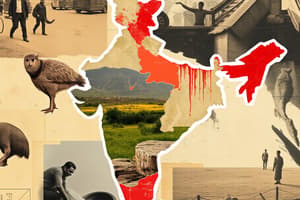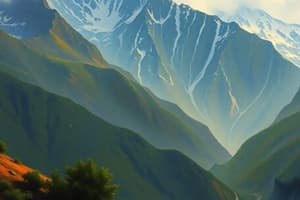Podcast
Questions and Answers
What is the reason behind the formation of the Himalayan Mountains?
What is the reason behind the formation of the Himalayan Mountains?
- Deposition of sediments by rivers
- Collision between the Indian and Eurasian tectonic plates (correct)
- Weathering and erosion of ancient mountains
- Volcanic activity
What is the characteristic of the rocks that compose the Peninsular Plateau?
What is the characteristic of the rocks that compose the Peninsular Plateau?
- Volcanic in origin
- Young and fold
- Formed by deposition of sediments
- Old and stable (correct)
What is the main feature of the Indo-Gangetic Plain?
What is the main feature of the Indo-Gangetic Plain?
- Narrow strips of land along the sea
- Fertile and densely populated (correct)
- Young and fold mountains
- Formed by volcanic activity
What is the process by which the Andaman and Nicobar Islands were formed?
What is the process by which the Andaman and Nicobar Islands were formed?
In which hemisphere is India located?
In which hemisphere is India located?
What is the total area of India?
What is the total area of India?
Which of the following countries does India share a border with in the south?
Which of the following countries does India share a border with in the south?
What is the length of India from north to south?
What is the length of India from north to south?
Flashcards are hidden until you start studying
Study Notes
Physical Features of India
Mountains:
- The Himalayan Mountains:
- Formed as a result of the collision between the Indian and Eurasian tectonic plates
- Young and fold mountains
- Extend from the Indus River in the west to the Brahmaputra River in the east
- The Peninsular Plateau:
- Composed of old and stable rocks
- Formed as a result of the wearing down of the ancient mountains
- Covers a large part of central and southern India
Plains:
- The Indo-Gangetic Plain:
- Lies between the Himalayas and the Peninsular Plateau
- Formed by the deposition of sediments brought by the rivers
- Fertile and densely populated
- The Coastal Plains:
- Narrow strips of land along the Arabian Sea and the Bay of Bengal
- Formed by the deposition of sediments brought by the rivers
Islands:
- The Andaman and Nicobar Islands:
- Located in the Bay of Bengal
- Formed as a result of volcanic activity
- The Lakshadweep Islands:
- Located in the Arabian Sea
- Formed as a result of coral reefs
India: Size and Location
Location:
- Lying entirely in the Northern Hemisphere
- Extends between 8°4'N and 37°6'N latitude
- Extends between 68°7'E and 97°25'E longitude
Size:
- Total area: 3,287,590 km²
- Length: 3,214 km from north to south
- Width: 2,933 km from east to west
- Coastline: 7,517 km long
Neighboring Countries:
- Shares borders with Pakistan and Afghanistan in the northwest
- Shares borders with China, Nepal, and Bhutan in the north
- Shares borders with Myanmar and Bangladesh in the east
- Shares borders with Sri Lanka in the south (separated by the Palk Strait)
Physical Features of India
Mountains
- Himalayan Mountains formed by the collision of Indian and Eurasian tectonic plates, extending from the Indus River to the Brahmaputra River.
- Himalayan Mountains are young and fold mountains.
Plateau
- Peninsular Plateau composed of old and stable rocks, formed by the wearing down of ancient mountains.
- Peninsular Plateau covers a large part of central and southern India.
Plains
- Indo-Gangetic Plain lies between the Himalayas and the Peninsular Plateau, formed by river sediment deposition.
- Indo-Gangetic Plain is fertile and densely populated.
- Coastal Plains are narrow strips of land along the Arabian Sea and the Bay of Bengal, formed by river sediment deposition.
Islands
- Andaman and Nicobar Islands are located in the Bay of Bengal, formed by volcanic activity.
- Lakshadweep Islands are located in the Arabian Sea, formed by coral reefs.
India: Size and Location
Location
- India lies entirely in the Northern Hemisphere.
- India's latitude ranges from 8°4'N to 37°6'N.
- India's longitude ranges from 68°7'E to 97°25'E.
Size
- India's total area is 3,287,590 km².
- India's length is 3,214 km from north to south.
- India's width is 2,933 km from east to west.
- India's coastline is 7,517 km long.
Neighboring Countries
- India shares borders with Pakistan and Afghanistan in the northwest.
- India shares borders with China, Nepal, and Bhutan in the north.
- India shares borders with Myanmar and Bangladesh in the east.
- India shares borders with Sri Lanka in the south, separated by the Palk Strait.
Studying That Suits You
Use AI to generate personalized quizzes and flashcards to suit your learning preferences.




